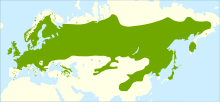Silver Birch
| Silver birch Betula pendula |
|
|---|---|
 |
|
| Silver birch forest, Inari, Finland | |
| Scientific classification | |
| Kingdom: | Plantae |
| (unranked): | Angiosperms |
| (unranked): | Eudicots |
| (unranked): | Rosids |
| Order: | Fagales |
| Family: | Betulaceae |
| Genus: | Betula |
| Subgenus: | Betula |
| Species: | B. pendula |
| Binomial name | |
|
Betula pendula Roth |
|
 |
|
| Distribution map | |
| Synonyms | |
|
See text |
|
See text
Betula pendula, commonly known as East Asian white birch,silver birch or warty birch, is a species of tree in the family Betulaceae, native to Europe and parts of Asia, though in southern Europe it is only found at higher altitudes. Its range extends into Siberia, China and southwest Asia in the mountains of northern Turkey, the Caucasus and northern Iran. It has been introduced into North America, where it is known as the European white birch, and is considered invasive in some states in the United States and in parts of Canada. The tree can also be found in more temperate regions of Australia.
The silver birch is a medium-sized deciduous tree that owes its common name to the white peeling bark on the trunk. The twigs are slender and often pendulous and the leaves are roughly triangular with doubly serrate margins and turn yellow in autumn before they fall. The flowers are catkins and the light, winged seed get widely scattered by the wind. The silver birch is a hardy tree, a pioneer species, and one of the first trees to appear on bare or fire-swept land. Many species of birds and animals are found in birch woodland, the tree supports a wide range of insects and the light shade it casts allows shrubby and other plants to grow beneath its canopy. It is planted decoratively in parks and gardens and is used for forest products such as joinery timber, firewood, tanning, racecourse jumps and brooms. Various parts of the tree are used in traditional medicine and the bark contains triterpenes which have been shown to have medicinal properties.
The silver birch is a medium-sized deciduous tree, typically reaching 15 to 25 m (49 to 82 ft) tall (exceptionally up to 31 metres (102 ft)), with a slender trunk usually under 40 cm (16 in) diameter. The bark on the trunk and branches is golden-brown at first, but later this turns to white as a result of papery tissue developing on the surface and peeling off in flakes, in a similar manner to the closely related Paper birch (B. papyrifera). The bark remains smooth until the tree gets quite large, but in older trees, the bark thickens, becoming irregular, dark and rugged. Young branches have whitish resin warts and the twigs are slender, hairless and often . The buds are small and sticky, and development is sympodial, that is to say the terminal bud dies away and growth continues from a lateral bud. The species is monoecious with male and female catkins found in the same tree. Some shoots are long and bear the male catkins at the tip, while others are short and bear female catkins. The immature male catkins are present during the winter but the female catkins develop in the spring, soon after the leaves unfurl.
...
Wikipedia
